Why meringue is not whipped into a thick foam. Learning to cook meringue
Ah, meringue! golden brown outside… Mmmm, enjoyment! There are already many recipes for how to cook meringue, I offer the most regular recipe, but I’ll tell you in detail what and how to do, so that everything works out for sure!
In general, the composition of the meringue is simple, like everything ingenious: proteins and sugar. However, a short list of ingredients does not mean that preparing a fragile dessert is easy and simple. Meringue is a delicate, capricious substance, like a spoiled lady, and can bring many surprises and disappointments to an inexperienced chef. Therefore, before you open the refrigerator and take out a tray with eggs, arm yourself with theoretical knowledge of the subject and strictly follow the strict rules for making meringue, and then you will succeed!
The finished meringue should be airy, tender, should just melt in your mouth, and at the same time be both fragile and crumbly. At the same time, stick to the teeth a little.
Ingredients:
Salt (or freshly squeezed lemon juice)
Egg white - 5 pcs
Sugar - 250 g
When whipping proteins, it is good to use citric acid - in powder, in diluted form, or just lemon juice. Lemon acid divorced at the rate of 1 tsp. powder for 2 tsp. water. Citric acid is added to taste, sometimes a few drops are enough.
Sometimes a pinch of salt is added to the proteins before whipping - it gives strength to the proteins.
Before you start churning the egg whites, turn on the oven at 110-120 degrees (or 100 degrees if you have an oven with a fan, and the color will turn out whiter). If you have gas oven without a thermometer, set the gas as small as possible to twist (so as not to go out).
1) It is best to beat the protein in a plastic, glass, copper or porcelain bowl. Aluminum utensils will give the proteins a gray tint.
2) We are all used to cracking eggs over egg whites, but given that the eggs may not be fresh, it's best to crack each one over a clean plate.
3) Carefully separate the protein from the yolk, because if the yolk gets into the protein (even a little bit!) The protein will not whip.
4) If fat gets into the protein (even a little, for example, from unwashed dishes), the protein will not whip!
5) Place the egg whites in the refrigerator for 30 minutes before whipping. ( better hour), then they will whip up better!
6) You can wipe the dishes in which you will whip the egg whites with lemon juice, beat out the whites and add a pinch of salt or lemon juice, then the whites will beat well and be fluffy!
7) Sugar should be introduced gradually, 2-3 tablespoons, and start beating with a mixer at a minimum speed and gradually increasing to medium. At maximum speed, it is better not to beat, as you risk missing the moment and killing the protein (the protein will settle and water will separate).
When the proteins increase in volume by 4-5 times, they will hold tightly on the broom, beating should be stopped.
The mass should be thick (about thick sour cream), should not spread and spread.
Using a spoon or pastry syringe, put the meringue on a baking sheet previously covered with parchment. I laid it out with a spoon (I didn’t want to toil with a pastry syringe). Another secret: any pastry is better behind white parchment!
Keep in the oven for a long time! It all depends on the amount of cooked mass, the thickness of the meringue and, most importantly, your oven ... For 5 proteins, you need to keep in the oven from an hour to 2. And perhaps even longer. For the first 40 minutes, I do not recommend opening the oven (especially since the meringue is definitely not ready yet!).
The finished meringue should be dry on top, and pierce with a toothpick, nothing sticks to it.
The finished meringue should be airy, tender, should just melt in your mouth, and at the same time be both fragile and crumbly. At the same time, stick to the teeth a little.
Hope everything works out for you! good luck and Bon appetit!
Meringue
Or meringues. Why two words for one type of pastry? Because confectioners are poetic people, they respect successful metaphors. Baiser - meringue, in French "kiss", meringue - meringue, or meringue cake. You can get confused, right? In one old French book, I found such a difference between these two words in relation to cuisine: meringue, in addition to the fact that a kiss is a ready-made cake after drying, and meringue is a mass of protein whipped with sugar, which can be both cream and a semi-finished product for soufflé , and much more.
Meringue is a pastry with a rich but difficult history. How many mixers were ruined during its preparation! How many coffee grinders burned down, in the sweat of their brow, making powdered sugar in the required industrial scale! How many tears and disappointments when cakes instead of white and airy turned out: a) hard and sticky b) flat and brittle c) dark brown ... Well, France, whatever you want, not an easy character ... But in fact, there are not so many dangerous moments that can ruin the future Poljot cake in the preparation of meringues. Let's start in order.
INGREDIENTS
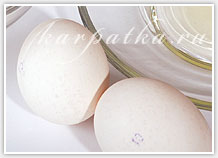
Squirrels. The fact that the eggs from which the proteins will be obtained must be fresh, I think, is unnecessary to mention. But the fact that the proteins are carefully separated from the yolks - I will mention, and more than once. Carefully - this means very carefully, so that the yolk shell remains intact. If it breaks, then there are no guarantees that not a drop of yolk got into the whites; which also means that meringues are canceled for today.
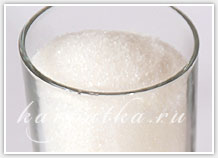
Sugar. Sugar preferably in the form of powder. If you take sand, then this will not affect the splendor of the meringue, but it will taste very good, the meringue will crunch, as if you are chewing sugar from a sugar bowl. However, if you beat longer, the sugar will eventually dissolve. But grind all the same into powder faster.
This is, in fact, everything. If you have powdered sugar and egg whites (and a mixer or a good whisk) - you have meringue. Everything else - you can add, or you can not add, the difference is small.
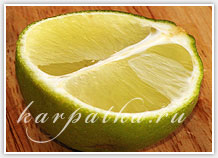
Acid. In the form of lemon juice, or dry citric acid, or diluted citric acid, or cream of tartar (exotic for our places, well, maybe someone from France sent a grandmother). The main thing is not in the form of vinegar. No, I didn’t think of this wonderful idea myself - I had a chance to try a purchased meringue with clearly noticeable notes of herring and dumplings. Of course, I understand everything, vinegar is cheaper, but at home you can do without such draconian ways to save money.
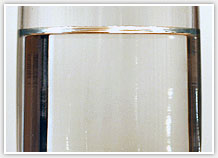
Water. It's not really a component, I just want to dispel one myth: many Soviet books say that water affects the foaming properties of proteins just as badly as fat. A drop of water, and you can say goodbye to the meringue. I trusted the printed word and all my childhood I wiped the dishes and whisks of the mixer dry and dry. And then I came across a recipe for meringue with syrup - that is, sugar with water. The meringues whipped perfectly, and I decided to experiment - I dropped a few drops of water into regular whites and tried to whip. They fluffed up like little ones. So you can not be afraid of wet dishes, the main thing is that it is clean and without traces of fat.
MAKE THE DOUGH
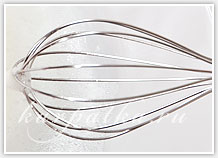
First you need to make sure that you have something to beat the egg whites. An ordinary whisk - an omelette egg beater - will not work, you will be making meringue with it until the second coming. You need either a good large whisk as in the photo (for those who are strong in spirit and hands), or a good powerful mixer (a weak one can burn), or a good powerful food processor with a fixed bowl and a large beater (ideal).

The second point that you should pay attention to is the dishes. As always, a rounded spherical bottom is best suited for whipping. The material also matters: aluminum will be the worst choice (squirrels turn gray in it), plastic is also so-so (quickly scratched with sugar and poorly washed from fat), copper utensils are pretty good (squirrels whip the fastest in it, but copper also has a lot of shortcomings and a small cart - it stands like a cast-iron bridge, and copper salts are also poisonous). The most practical stainless steel and heat-resistant glass.
The dishes and what you will be whipping with (whisker, whisking part of the mixer) must be DEGRATED. Fat in any form for meringue is a death sentence, that at the beginning of beating (then the proteins will not be whipped), that at the end (then they will become liquid). Degrease - this is simply a good wash, burn or wipe with acetone unnecessarily.
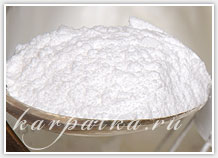
Yes, sugar. If you have already bought it in the form of ready-made powdered sugar, no pre-treatment not required. Well, maybe sift ... But granulated sugar will have to be ground, and in 99% of cases this will be done in a coffee grinder. So, if you grinded coffee in a coffee grinder to sugar (and you most likely grinded it, you didn’t buy it for sugar), nuts, crackers or any other fat-containing products - you need to wipe the coffee grinder well, very well first with a damp sponge, and then dry with a tissue. If the sugar is with the smallest fragments of nuts, you will not taste them, but the proteins from whipping with such sugar will settle.
What will happen if you do not grind sugar, but add it as it is, with sand? It's okay if you have a VERY powerful mixer or VERY strong arms and elephant-sized patience. If you beat the whites with sugar for 15 minutes, or even longer, then sooner or later the sugar will dissolve. But if patience is not enough, the meringue will turn out with grains and maybe even hollow inside.

Now about eggs. Carefully, very carefully and carefully separate the protein from the yolk. It is better not to break an egg with a container of proteins, but over a separate small cup. Rotten eggs in stores are now a rarity, but you must admit that it is much less offensive to find this rarity in a separate container, and not in a mixer bowl with ten squirrels already separated. And when breaking, you can damage the yolk, and in a separate cup this will not bring any grief, just for breakfast your husband will have to eat an omelette not from 2, but from 3 eggs. But if this yolk gets to already separated proteins, breakfast has a chance to enrich itself not by 1, but by 4 or 6 (or how many eggs you have already divided there), and so much cholesterol at a time is harmful.
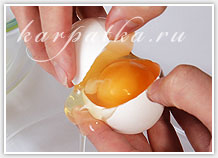 The process of separating yolks and whites is not as difficult as it seems. Once - they hit an egg on a sharp object (the edge of a cup, the blunt side of a knife). It is necessary to knock carefully so that the egg cracks, and not crumble into many small fragments. Two - slowly divided the egg into halves (while the egg is standing so that the fault line runs horizontally). The straighter the line, the less chance of cutting the yolk with a sharp corner. The excess part of the protein wants or does not want to spill out of the egg into a bowl. Three - we have an empty upper half of the shell on our hands and the lower one with the yolk and some protein. Pour the yolk into the empty half so that the protein spills out. Having made such transfusions a couple of times, you will find that one naked yolk dangles in the shell. Transfer it to a separate bowl and start working on the next egg. |
And a few words about the temperature of the eggs to be beaten. Some guides recommend only beating chilled eggs. Others insist on room temperature. Still others advise even slightly heating the proteins. I've tried this and that - no difference. fresh eggs+ good mixer = fast and excellent meringue. And manually, both chilled and warmed proteins should be whipped almost until the second coming, or rather, about 20 minutes.
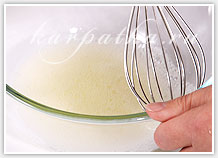 When the yolks are removed, the whites need to be beaten. We add lemon juice or other acid now, at the very beginning of whipping, it is needed not for taste, but to speed up the transformation of proteins into dense foam. At first, the proteins will be covered with foam with large bubbles, but the longer you beat them, the more the proteins will take up space, the whiter the foam will become and the smaller the bubbles will be in it. Sugar, by the way, can be added already in the middle of beating, it does not interfere with the formation of a strong foam, and on the contrary, it contributes. In general, if there are three ways to cook meringue (why such nationalities were chosen, I have no idea, how I don’t know if there are fourth and fifth ways, let’s say Turkish and Spanish): |
1. French.
The simplest, beat the whites to a strong foam, pour in sugar (powder), beat, beat again, so that the mass finally gets stronger and thicker, and that's it.
Difficulty: **
Application: meringue to dry, simple shapes. In this mass, the bubbles, although small, are visible to the eye, and fine patterns can swim.
2. Italian.
The beginning is the same as the previous method, beat the whites. But we don’t pour sugar, but pour it in, because first we cook syrup from it, until it is tested for a hard ball (as in fudge sugar, only there the ball was soft). Pour hot syrup. Carefully, in a thin stream, and after pouring all the syrup - do not stop whisking, whisk until everything cools down. It is difficult for one to do this, one beats, the second pours. But if you have a mixer. In which the bowl stands by itself, and the whipping part is fixed, then you can handle it alone.
Difficulty: ****
Application: creams. Hot syrup brews proteins, and now the resulting mass can be safely eaten. You can layer the cake with Italian meringue, fill the tubes, decorate the dessert. Italian meringue mixes well even with butter(French from contact with fat flows). Can of course be made Italian meringue meringue, but then it makes sense to suffer so much with syrup, if then there will still be heat treatment? And then the syrup is excess water.
3. Swedish.
The most difficult, because in a water bath. The utensils with proteins and sugar are placed over a pot of boiling water (the mixer must be used with great care), and beaten, slowly at first so that the sugar dissolves, then quickly, so that a lush and thick mass of meringue is obtained.
Difficulty: *****
Application: decoration. Using this method, the strongest, thickest and most stable mass is obtained. She can draw the most complex and beautiful patterns, and after half an hour it will not flow, but will only dry out. From this mass, again, meringues can be dried, and they dry the fastest (apparently, during whipping in a water bath, part of the moisture has time to evaporate) and turn out to be the most beautiful.
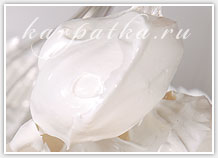
The finished mass of meringue, no matter how you make it: very white, very thick, and most of all looks like shaving foam, only much thicker. If you remove the whisk from it, the meringue remains standing in a peak, sticks tightly, and does not flow down from the wire in a trickle. If the meringue is pouring - this is underwhipped meringue, it still needs to be whipped and whipped. Well, you can also roughly navigate in time: 10-15 minutes with a mixer, 20-30 with your hands, you can’t get a strong mass of meringue in 2 minutes.
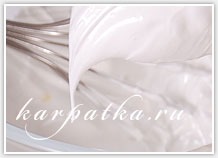
The term "whipped to stiff peaks" is often used in relation to it. Peaks are easy to see: scoop up meringue with a spoon, or dip your finger into it. There will be sharp-looking fragments here and there at the edges. Sharp - meaning that they behave regardless of gravity: they do not bend down, do not sag no matter how you twist the spoon.
How to beat - a hand whisk or a mixer? Well, as you probably guessed from the previous text, I don't really like these 20-30-minute workouts in the kitchen. If you have a good powerful mixer or even better - a combine, entrust meringue to them, you will find something to occupy these 20-30 minutes. True, a weak meringue mixer can burn, especially if you make meringue hot or with syrup.
PREPARING FORM

Meringue is usually made in the form of individual cakes on a baking sheet or wire rack. So it dries faster and the construction is stronger - the meringues are fragile, like the first ice, and the thin cake breaks in 9 cases out of 10. But the round meringue pie does not. But in principle, you can also make a cake, a baking sheet for it is prepared in the same way as for placer bezes. Namely: it is necessarily lined with some kind of non-stick material. If you put the meringues on the most well-oiled baking sheet, it is unlikely that you will be able to tear them off after baking, the meringues stick to the butter better than to the Moment glue. But it is already much easier to separate the meringue from a flexible piece of paper. The main thing is that the paper should also be either oiled or specially intended for baking.

Of the non-stick materials, the worst choice would be a silicone mat: it makes it difficult for the bottom to dry out, and the finished meringue does not stick well. The foil is also the best option. Quite decently behave woven non-stick sheets impregnated with Teflon. But the best option is baking paper. It is translucent, you can draw perfectly even circles or ovals on it and deposit the same perfectly even cakes on them.
LAYING OUT THE DOUGH
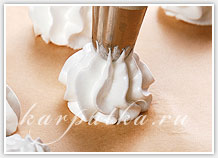
As in the case of custard dough, life is incredibly easy with such a simple thing as pastry bag. The meringue mass is sticky, thick, spread it on a baking sheet with a spoon a) for a long time b) meringues will be of the most diverse (most often ugly) forms. And spreading an even circle for a cake with a spoon is generally clean water perversion. Those tricks that helped us out in the case of custard dough (wet spoon) are not so good for meringue: we dry it, and then excess water drips from the spoon. And the irregularities choux pastry disappear, because it swells in the oven, and what meringue was raw, this will be dry. So either put up with extremely uneven meringue shapes, or get hold of a bag.

Filling the bag with a mass of meringue also requires special skill. The choice of nozzle is a matter of taste, you want smooth and round bezes, you want carved roses. You can plant meringues almost close to each other; when baking, they do not increase in volume (there is nowhere else). If you want to make cakes of a certain shape, round or oval, and not just small pimps, do not be too lazy to either draw the wrong side of the cooking paper on a stencil (the stencil can be the stem of a wine glass, or even a children's sandbox mold), or cut a white paper stencil and put it under the culinary one, and squeeze the meringue along these contours. Even if you are a fourth-generation draftsman, you may not be able to get perfect circles with a bag of meringue, and the cake eraser has not yet been invented, and Ctrl + Z does not work here. Why is it necessary to draw the inside out, is it also worse to see? And then you want the graphite from the paper to stick to the meringue? Do you mind? Then you can draw on the front.

For a cake, you definitely need to outline the outline, it is incredibly difficult to draw a large even circle for meringue. And be sure to extrude concentric circles, you want from the middle to the edge, you want from the edge to the middle. This is not important, it is important that the meringue is squeezed out in one continuous ribbon: such a circle will be much stronger than if you make a cake consisting of densely planted roses. The second one is easier to make, and it looks more beautiful, but it is impossible to separate it from the paper without breaking it. And it's not good with paper. Yes, do not forget to plant a few small bezes next to the cake of the same thickness as the cake. Useful for decoration, and most importantly - for sampling, do not break off a piece of cake later.
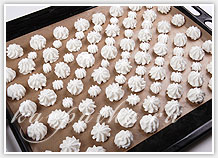
The oven can be preheated, or you can not preheat, the main thing is that it allows you to keep low temperature, namely 100 degrees Celsius. In this sense, there are usually no problems with electric ones, they can be set at least 40. But gas ones often have a minimum temperature of 120-130 degrees, nothing less - a live fire warms there. And 120-130 is too much for meringues, and they turn out not snow-white, but caramel color and taste. But some people like it even better.
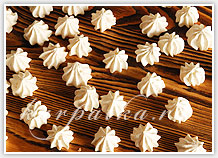
We put the meringue in the oven, and you can not remember about it for half an hour. Then open the oven door a little: you will be blasted with hot, moist air. It's good that you released it, so the meringue will dry faster. At the same time, see if the meringues have begun to turn yellow. If we started, and the thermometer shows 100 C, lower the temperature and remember - the thermometer is lying. At 100 degrees, sugar does not caramelize.
How long will it dry? Depends on the size. Tiny one-bite roses will dry in less than an hour, a thick cake can dry in three. You need to check the taste: tear off one bezie (it’s nothing that it feels soft to the touch, they are always hot), let it cool for a couple of minutes and eat it. Dry and crispy even inside? Ready. Is the center still sticking to your teeth? Let it dry. Yes, if when you open the oven door, the air comes out clearly humid, you don’t have to bother to tear off the meringue, it definitely hasn’t baked yet (more precisely, it hasn’t dried out).
If you have an oven with an auto-off (usually it works after 3 hours of operation), then baking meringues is easier than ever. They put it in the oven and went to bed. After 3 hours, it will turn itself off, and in the morning you will get a perfectly dried and already cooled meringue.
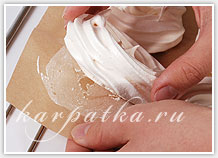
First of all - do not rush, and do not tear off the meringues hot. Firstly, you can get burned, and secondly, cripple the meringue while they are hot, they are soft and very reluctant to part with their homes. But when they cool down (they cool down very quickly) - they are separated from the paper, or with what you laid the baking sheet there, without any objections.
But without objection, however, only small and round bezeshkas are separated. The thinner and larger the area of the meringue, the less it reveals the desire to leave the baking sheet safe and sound: they break with a bang. So a special approach is needed here: put the cake on the edge of the table and start moving, supporting it under the bottom with one hand, while pulling the paper down with the other. In a minute, you will have a cake in one hand, and a piece of paper in the other.
Ready-made meringues can be eaten right, you can glue them into a cake (for example, Poljot), you can glue small meringues in pairs with any cream or chocolate, you can stuff them with ice cream, you can mix them into cream ... There are a lot of options. But remember - after twelve hours, the meringue turns into a poke ... no, this is from another fairy tale ... Meringue cannot be glued with low-fat creams! More precisely, you can, but only if you plan to eat them right now. Well, or after 5-10 minutes, then it’s possible and even very tasty: meringue with fresh strawberries and yogurt ... or ice cream and chocolate sauce... But for storing ice cream, whipped cream, yoghurt creams, berry sauces, fresh berries categorically they are not suitable as a filling - the meringue gets soaked from such fillings, and instead of dry crispy shells, you get something soft and sticky to your teeth.
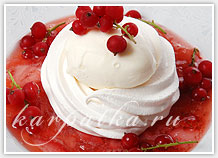
But with butter cream meringue feels great, does not lose fragility and friability. True, the cream should be decently fat, from 82% butter and cream: minus fat means plus moisture, and moisture just spoils the meringue. And this case should be stored in the refrigerator, in the heat the meringue will get wet and from butter cream. But you can also freeze.
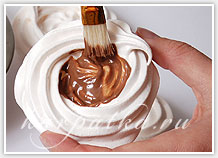
If you really want to fill the meringue with something less fat, you need to prevent the contact of this something with the meringue, then the life of the cake will last. What is suitable as insulation? Chocolate. He himself will not soak the meringue, there is nothing, and isolates it from destructive contact with cream or ice cream. Lubricate the bottoms of the meringues (or the entire surface of the cake) with chocolate, let it harden, and fill with almost anything. After this meringue, if you do not plan to eat it in the next hour, it is best to send it to the freezer.

But in general, it is best to store meringues without filling, and stuff them with anything before eating. Then it lies perfectly even at room temperature, the main thing is to pack it hermetically, because the meringue can suck moisture even from the air.
PS And a completely breathtaking thing is made from meringue - sculptural fruits. " Good kitchen» Terra wrote about them. But in terms of complexity, this is something terrible. Meringues are made in the form of hemispheres, the middle is scraped out of them with a spoon. These shells are stuffed with orange mousse, the halves are folded to full balls. Freeze and then pour orange fondant(which, by the way, also needs to be done - and this is not the easiest event), let it freeze. And they stick a clove into each orange - instead of a twig ... It's good not to poke each fruit 200 times with a needle to create the full effect orange peel. I don't dare - but I want to.
| 20.04.2010 |
Not so long ago, our editors received several questions about meringues and meringues, how to properly prepare meringues, how to make colored meringues, why meringues turn yellow when dried. We have raised this issue for discussion in our instagram. However, so that henceforth our readers do not have any difficulties with meringues and meringues, food blogger Lisa Bogomazova wrote a great article in which she talked about the solutions to many problems in the process of taming these cute sweets.
Meringue is one of the easiest desserts to prepare, which, nevertheless, still raises a lot of questions and difficulties in the cooking process.
According to the method of preparation, there are three types of meringues:
- French meringue - egg whites beaten with sugar and/or powdered sugar. The most popular method for further preparation crisp airy meringues.
- - it is prepared from proteins whipped with sugar in a water bath. It is used to obtain products such as meringues, meringues (dry crisp, and inside - a moist soufflé core), as well as creams.
- Italian meringue - whites whipped into foam with hot sugar syrup. Most often used for decoration, creams and other meringues that do not require further heat treatment. It is most stable over time and during baking, which explains its popularity in the preparation of pasta cakes.
Of the three types listed above, the simplest is french version cooking. Let's talk about how to whip the meringue in this way in order to bake meringue in the future.
#1 Fresh eggs take longer to beat, because. contain more moisture.
#2 It is easier to separate the yolks from cold eggs, because. their shells are stronger, and cold egg whites whip a little faster, but warm egg whites make a more airy, glossy and stable meringue.You can separate the whites from the yolks of fresh cold eggs in advance, and then let them "age" for a couple of days in the refrigerator, and then warm up to room temperature before whipping.
#3 For one egg protein of the first category, about 50 g of sugar is required.
#4 Not a single micron of yolk should get into the protein, otherwise it will not whip.
#5 Also, the bowl itself, in which you whip, must be absolutely dry and fat-free. Wipe with vinegar and dry the container with a dry, clean cloth if in doubt. It is better to use glass or metal containers.
#6 For snow-white meringue, add a couple of drops of lemon juice, which is also a preservative and stabilizer for meringue. Salt is also a stabilizer for protein foam.
#7 If you want a caramel-colored meringue, increase the amount of sugar by about 1/4 and dry the meringue a little longer than usual at a temperature of 105-110 degrees. The taste of such meringues will also be different, they acquire a caramel note or resemble the taste of creme brulee to someone.
#8 All sugar in the process of whipping should completely dissolve and bind with protein molecules.If you are still afraid that all the sugar will not dissolve, replace half with powdered sugar.
#9 It is easy to beat the whites, then the mass will be too porous and will quickly fall off, but a dense, smooth, shiny mass should be obtained, so it is recommended to beat first at low speed.
#10 If you want to color the meringue, then it is better to use gel or dry dye, which is added at the very end. Remember that the raw meringue should be slightly brighter than the color you want to end up with. a small part of the dye still burns out during baking.If you are still afraid that the meringue does not like moisture, and there is too much gel dye, then add a pinch cornstarch when whipping.
How to cook meringue:
Step 1. First, beat the whites with a pinch of salt at low speed until foam appears, then gradually introduce sugar (remember, 50 g of sugar is needed for 1 egg white of the first category), increase to medium, at maximum speed - at the very end. At this stage, you can add a dye, vanilla, coconut or other extract.
We beat the meringue to firm peaks - on the whisk raised up, a pointed stable “beak” should be obtained that does not fall off over time, and the protein mass will remain at the bottom even if the bowl is turned upside down.
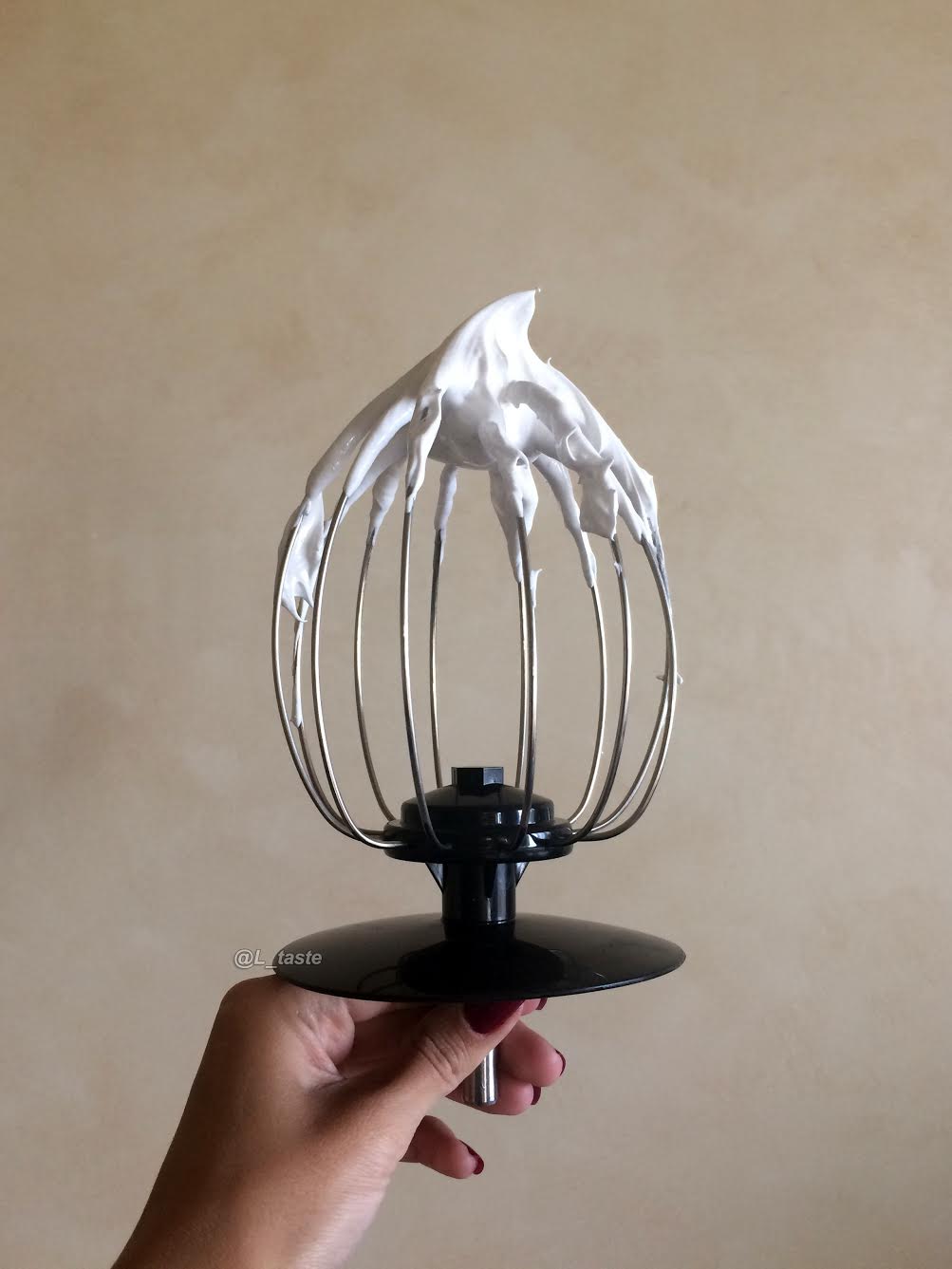
Step 2 Place the meringues on a baking sheet lined with parchment.
Step 3 We bake in a preheated to 100 degrees for an hour or two, depending on the size of the meringue. For small crispy bezeshki, it takes no more than 1.5 hours. After an hour, you can open the oven and take a sample to see if the meringue is ready. Let the meringue cool in the oven.
If the meringue still turned out to be a caramel color, reduce the temperature next time to 80-95 degrees and dry the meringue in the oven longer.
It is impossible to store meringues in the refrigerator, as they become damp; they can keep for about a week in an airtight container.
COMPOUND
3 squirrels, 1 cup fine sugar or powdered sugar (200g)
Adviсe
Eggs for cooking meringue can be taken both cold and at room temperature. Chilled proteins whip faster than warm ones, but the foam is less stable. Proteins at room temperature whip much longer, but the foam is stiffer, higher and more stable. If the eggs are old, then warm proteins may not whip at all, while cold ones will make soft foam.
It is better for novice cooks to learn how to whip meringues from cold proteins, since the foam turns out much faster, and long whipping of warm proteins can frighten inexperienced cooks.
***
Eggs should not be completely fresh, but not too old either. The optimal freshness of meringue eggs is 1~3 weeks from the time they are laid by the hen, provided the eggs have been stored in the refrigerator.
Some sources recommend using the freshest eggs, but these eggs produce a low, albeit firm, foam.
If you use very old (stale) eggs, the foam will be soft, and liquid will collect at the bottom of the dish. In addition, meringue from stale eggs may have a specific smell of the shell.
***
Whipping utensils must be completely fat-free. It is advisable to have a special bowl (the link is a good selection of dishes wholesale and retail), which will be used only for whipping egg whites. If there is no separate bowl, then the bowl for whipping should be washed well. hot water and clean baking soda. Then dry and rub dry with a slice of lemon. It is also advisable to wipe the whisk with lemon.
Whip egg whites into aluminum cookware forbidden. Aluminum oxides turn into protein, which worsens the taste of the meringue and changes its color to gray.
***
You can use a hand mixer or a hand whisk to beat the eggs. It is impossible to whip proteins with a blender, since it has short blades and they cannot capture air.
***
Meringue (meringue) is of two types - hard and soft.
To obtain a solid meringue, the weight ratio of protein and sugar should be 1: 2, i.e. 66 g of sugar is required for 1 large protein weighing 33 g.
To prepare soft meringue, the ratio is 1:1. Soft meringue is more tender than hard meringue and its foam is less stable. This meringue is used to cover pies.
***
The addition of acid when whipping proteins stabilizes (strengthens) the walls of the air bubbles. As an acid, you can use lemon juice, vinegar, vinegar essence and wine stone.
For 3 eggs put on a choice:
- 1 teaspoon of lemon juice;
- 1 teaspoon 4~6% vinegar;
- 3~4 drops of vinegar essence.
Excess acid will give the meringue sour taste. When used disproportionately a large number meringue vinegar can acquire a specific smell.
***
When sugar is used, the meringue is firmer and more crunchy due to the undissolved sugar crystals. When baking, the surface of the meringue may crack. Large bubbles may form inside the cookies. Sometimes drops of syrup may form on the surface of meringues whipped with strong crystalline sugar during baking. This is because the sugar crystals absorb moisture and dissolve to form a syrup.
Meringue on powdered sugar is whipped longer than on sugar. The foam is lower.
***
If the whites are beaten too long, the foam loses stability. The bubbles burst, and the proteins that make up the bubble film are collected in lumps. In appearance, the foam turns out to be granular or flaky, liquid forms at the bottom of the bowl, and the shine disappears.
Such overwhipped proteins are not recommended for baking, it is better to put them on the dough for the pie.
***
For the preparation of meringue, you can use frozen proteins, after defrosting them in the refrigerator to a liquid state.
However, frozen proteins may only reach "soft peaks" when whipped. To obtain a firm foam, frozen proteins must be mixed with fresh ones in a 1: 1 ratio.
meringue cooking
Separate the egg whites from the yolks. Use the yolks in another dish.
When separating the protein and yolk, split the egg shell into two halves and pour the yolk several times from one shell to another, while the protein will drain into the substituted dishes.
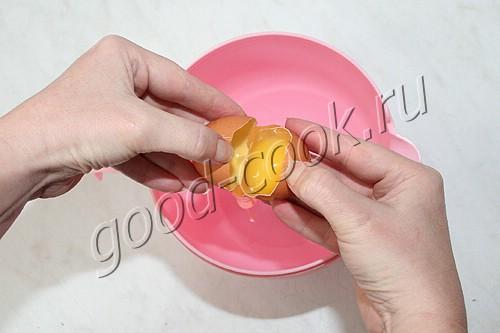
Inexperienced housewives can release proteins one at a time into a separate bowl, and only then pour into a large bowl for whipping.
With this method of separating proteins, if the yolk hits, only one protein will be spoiled, and not all.
The ingress of yolk into proteins is unacceptable, since the yolk is 10 ~ 12% fat, and fat violates the integrity of the foam.
Put the whites in a clean bowl and start beating with a mixer, first at low speed, then increase it to the maximum.
1st whipping stage
The bubbles are large. The walls of the bubbles are thick, the foam is not strong, similar to soapy. There is a lot of unwhipped liquid at the bottom.

2nd stage whipping - "Soft peaks"
As the beating continues, the volume of the foam increases and the size of the bubbles decreases. The foam becomes whiter.
There is no liquid at the bottom or there is a very small amount. If you touch the foam with a spoon and lift it up, then the whipped mass will follow the spoon. After it comes off the spoon, the sharp tip will bend down.
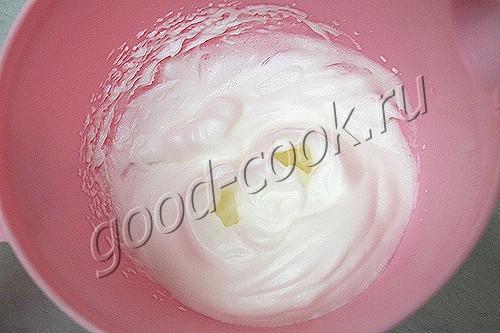
After obtaining such a foam, you can begin to introduce fine sugar or powdered sugar.
Set the mixer to medium speed.
Without stopping whisking right under the blades, pour sugar or powdered sugar in a very thin stream.
If you add sugar quickly, the foam will remain soft as a result.
If the eggs are large (more than 50 grams without shell), then for each protein you need to add 1 tablespoon of sugar.
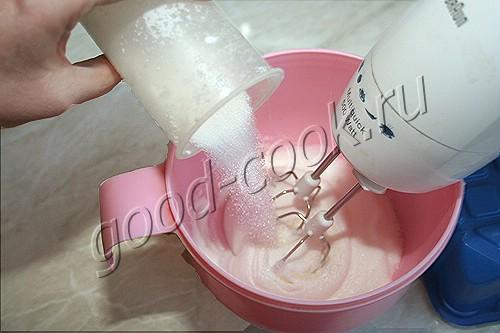
State "soft peaks" It is characterized by the fact that when the rim is lifted up, the protein mass does not flow down, but remains on the rim. The sharp tip is bent down.
At this stage, lemon juice or vinegar can be added to the mass.
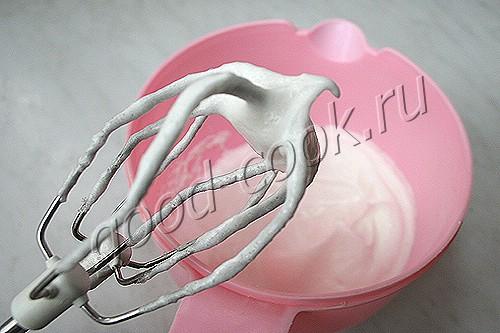
3rd stage of whipping - "Hard peaks"
When all the sugar is introduced into the proteins, you need to continue beating, increasing the mixer speed to maximum.
The foam becomes more rigid, dense, smooth and shiny.
When removing the corolla, the protein forms a sharp top that does not fall down.

cookie molding
Line a baking sheet with baking paper.
Submit protein mass spoon or squeeze it out of the bag with the star nozzle.

If there is no nozzle, then the mass can be put in a plastic bag, cut off the tip from it and squeeze out the cookies.
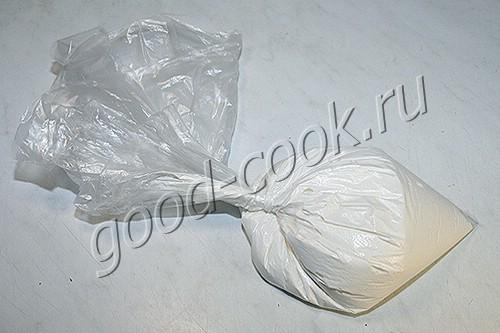
Cookies need to be placed at a distance from each other, as they increase in size during heating.
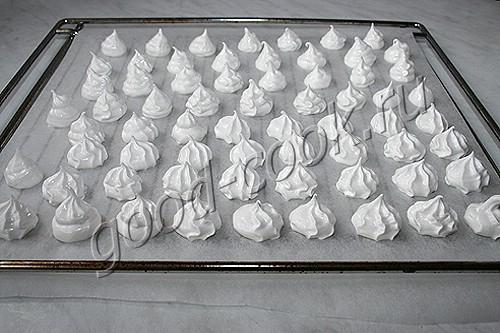
Preheat the oven to t=80~115°C.
The temperature must be selected for the oven individually.
The higher the temperature, the more likely the meringue will turn pinkish as the sugar caramelizes.
Put a baking sheet in it for a period of 40 minutes to 3 hours - the drying time depends on the size of the meringue.
When drying meringues, keep the oven door slightly ajar.
If there is a ventilation mode, turn it on.
Cookies should be easily separated from the paper, become light and rustling. Readiness is best determined by removing one cookie and breaking it in half - the inside of the meringue should be dry, not sticky or gooey.
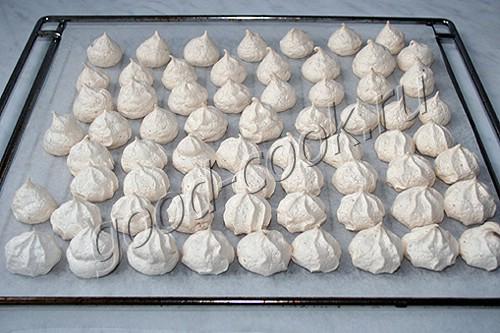
When the products are completely dry, turn off the oven, leave the door ajar. Leave the meringue in the cooling oven for another 20~30 minutes.
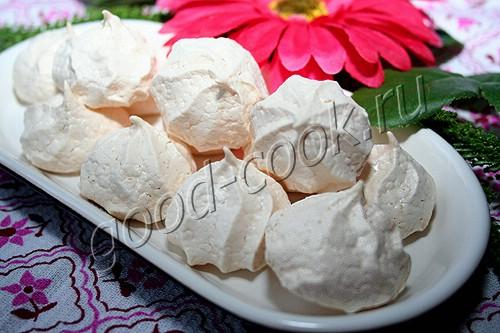
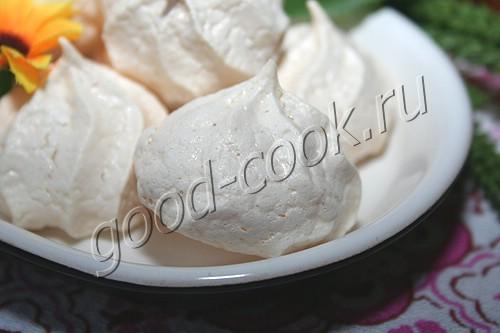
Ah, meringue!.. Tender, crispy, crumbly, or, on the contrary, soft, like cotton candy inside and with a crispy ruddy crust on the outside ... Mmm, pleasure! No wonder the refined French called this delicacy a “kiss” (from French Baiser). IN pre-revolutionary Russia meringue was called "Spanish wind". It is also called meringues, and it is believed that it is more correct to call this dessert that way, because meringue is protein cream, and meringues are the same cream, only dried. However, let's leave linguistics aside and try to cook this amazing dessert.
In general, the composition of the meringue is simple, like everything ingenious: proteins and sugar. Sometimes nut flour, starch, but this is not so significant. However, a short list of ingredients does not mean that preparing a fragile dessert is easy and simple. Meringue is a delicate, capricious substance, like a spoiled lady, and can bring many surprises and disappointments to an inexperienced chef. Therefore, before you open the refrigerator and take out a tray with eggs, arm yourself with theoretical knowledge of the subject and strictly follow the strict rules for making meringue, and then you will succeed!
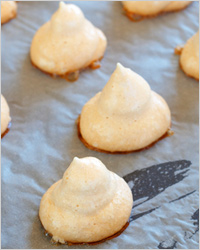 You can cook meringue in three ways. french way- the simplest, it can be used for trying to master this dish, as well as for making meringue simple shapes, without subtle patterns. The protein mass turns out to be lush, strong, but with clearly visible bubbles, so there is no point in planting virtuoso roses on a baking sheet, they will melt. Meringue is prepared in French like this: chilled proteins are whipped to a strong foam with a pinch of salt, then sugar or powdered sugar is added little by little and everything is whipped to the so-called “hard peaks”. This means that if you lift the whisk or mixer over the egg whites, they won't fall off and the spikes won't bend under gravity. Italian way cooking meringue differs from French meringue in that instead of sugar, rather steeply cooked meringue is poured into whipped proteins. sugar syrup. The syrup is poured in a hot, thin stream, and the whipping of the proteins in no case stops until the whole mass has cooled.
You can cook meringue in three ways. french way- the simplest, it can be used for trying to master this dish, as well as for making meringue simple shapes, without subtle patterns. The protein mass turns out to be lush, strong, but with clearly visible bubbles, so there is no point in planting virtuoso roses on a baking sheet, they will melt. Meringue is prepared in French like this: chilled proteins are whipped to a strong foam with a pinch of salt, then sugar or powdered sugar is added little by little and everything is whipped to the so-called “hard peaks”. This means that if you lift the whisk or mixer over the egg whites, they won't fall off and the spikes won't bend under gravity. Italian way cooking meringue differs from French meringue in that instead of sugar, rather steeply cooked meringue is poured into whipped proteins. sugar syrup. The syrup is poured in a hot, thin stream, and the whipping of the proteins in no case stops until the whole mass has cooled.  This method is ideal for making creams - boiling syrup brews proteins, and the resulting cream does not fall off. With this cream, you can layer cakes, cook cakes with it, fill tubules or eclairs, decorate any dessert. In addition, cream prepared in Italian mixes perfectly with butter, while “regular” meringue flows from contact with fat. swiss way cooking meringue is the most time-consuming, due to the fact that you have to build steam bath. But the meringue prepared in this way is the strongest, most persistent and dense. From the steamed mass, you can deposit the most fancy cookies, and they dry out very quickly, faster than all the others, and you can draw beautiful complex patterns with it. The method of preparation is as follows: a bowl with proteins and sugar is placed over a pot of boiling water, and the bottom of the dish should not come into contact with boiling water, and the proteins are whipped, first slowly until all the sugar has dissolved, and then quickly, to get a thick, dense mass.
This method is ideal for making creams - boiling syrup brews proteins, and the resulting cream does not fall off. With this cream, you can layer cakes, cook cakes with it, fill tubules or eclairs, decorate any dessert. In addition, cream prepared in Italian mixes perfectly with butter, while “regular” meringue flows from contact with fat. swiss way cooking meringue is the most time-consuming, due to the fact that you have to build steam bath. But the meringue prepared in this way is the strongest, most persistent and dense. From the steamed mass, you can deposit the most fancy cookies, and they dry out very quickly, faster than all the others, and you can draw beautiful complex patterns with it. The method of preparation is as follows: a bowl with proteins and sugar is placed over a pot of boiling water, and the bottom of the dish should not come into contact with boiling water, and the proteins are whipped, first slowly until all the sugar has dissolved, and then quickly, to get a thick, dense mass.
 So, the cooking method is chosen, and you are determined to surprise your guests with wonderful meringues. Stop for a few more minutes and remember a few very important rules without which you can't do anything.
So, the cooking method is chosen, and you are determined to surprise your guests with wonderful meringues. Stop for a few more minutes and remember a few very important rules without which you can't do anything.
Proteins must be fresh! Only fresh proteins are able to retain air and give a dense thick mass.
 . Separate the whites very carefully so that not a drop of yolk gets into them. This is done as follows: over a separate dish, break the egg with the blunt side of the knife so that the shell cracks. Carefully break open the egg and release the protein into the bowl. The yolk remains in one of the shells. Just carefully pour the yolk into another shell, while the remaining protein slips into the bowl, and the clean, intact yolk remains in the shell.
. Separate the whites very carefully so that not a drop of yolk gets into them. This is done as follows: over a separate dish, break the egg with the blunt side of the knife so that the shell cracks. Carefully break open the egg and release the protein into the bowl. The yolk remains in one of the shells. Just carefully pour the yolk into another shell, while the remaining protein slips into the bowl, and the clean, intact yolk remains in the shell.
Try to break each egg over a separate bowl, pouring the whites into a bowl - a surprise in the form rotten egg flopped into the rest of the squirrels, no one will find it pleasant.
It is advisable to grind sugar into powder or buy ready-made powdered sugar in the store. The size of the grains will not affect the quality and taste, you just have to beat the protein mass much longer, because this must be done until all the sugar has dissolved. Otherwise, the remaining grains will crunch on your teeth.
 . When whipping proteins, it is good to use citric acid - in powder, in diluted form, or just lemon juice. Citric acid is diluted at the rate of 1 tsp. powder for 2 tsp. water. Citric acid is added to taste, sometimes a few drops are enough, but if you like a sour taste, you can add more, for example, a teaspoon of acid. Just don't use, for heaven's sake, acetic acid!
. When whipping proteins, it is good to use citric acid - in powder, in diluted form, or just lemon juice. Citric acid is diluted at the rate of 1 tsp. powder for 2 tsp. water. Citric acid is added to taste, sometimes a few drops are enough, but if you like a sour taste, you can add more, for example, a teaspoon of acid. Just don't use, for heaven's sake, acetic acid!
Dishes and whisks should be not just clean, but perfectly clean, free of grease and any impurities.
It used to be thought that even a drop of water could negate all efforts to beat the egg white. This claim is now being debunked. experienced chefs, and some even add a few tablespoons of water to the proteins so that the dried meringues become especially brittle and dry.
Sometimes in egg whites before whipping 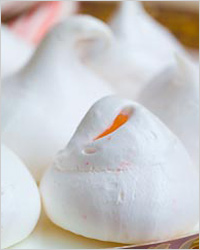 a pinch of salt is added with it - it gives strength to the proteins.
a pinch of salt is added with it - it gives strength to the proteins.
If the recipe calls for adding a little flour, starch or ground nuts, then the flour and starch should be sifted to saturate them with air, and the nuts should be fried and ground as thinly as possible.
Baking trays for baking meringue should be covered with oiled or special paper for baking.
If you decide to bake air baskets, then draw identical circles on the back of the baking paper (circle the bottom of the glass), fill cream injector or cornet with a smooth round nozzle and fill the circles by squeezing out the dough, moving in a spiral. Then, along the edge of the circles, deposit the dough in the form of a side in one continuous strip, or often plant small stars along the edge. After baking and cooling, fill the resulting baskets with cream or jam.
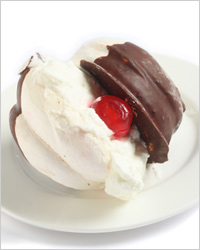 . To get even cakes on the back of the paper, draw a circle or rectangle of the desired size with a pencil, then put the dough into a confectionery syringe or cornet and deposit the meringue along the outlined contour, moving in a spiral. You can start from the center, or you can start from the edges, it doesn’t matter.
. To get even cakes on the back of the paper, draw a circle or rectangle of the desired size with a pencil, then put the dough into a confectionery syringe or cornet and deposit the meringue along the outlined contour, moving in a spiral. You can start from the center, or you can start from the edges, it doesn’t matter.
In order to remove the meringue cakes from the paper, place the cake along with the paper on the edge of the table and slowly slide it towards you, holding the cake with one hand, while pulling the paper down with the other. Acting carefully enough, you will get the cake whole and unharmed. Removing small meringues from paper is usually not a big deal.
To prevent the meringue from melting under the influence of cream, jam or jam, make a layer of melted chocolate. To do this, melt on grated chocolate in a water bath a small amount milk or cream, stirring constantly and periodically removing from steam so that the chocolate does not curdle from excessive high temperature, stir until smooth and smear the inside of the baskets with a brush, trying to apply chocolate in a good such layer. The same operation can be done with cake layers - this will only add a crispy chocolate note to your dessert.
That's all. Difficult? Try it and see for yourself.
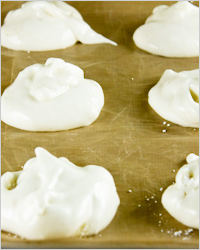
Ingredients:
4 egg whites(from medium eggs),
1 stack sugar (or half sugar with powdered sugar)
1-2 tsp vanilla sugar.
Cooking:
Start whipping the whites (you can add a pinch of salt) with a whisk or a mixer at a slow speed to get a bubble mass. Gradually, without stopping beating, pour in the sugar, beating each time until the sugar is completely dissolved. Properly whipped whites do not fall off the whisk and hang down from it. On a baking sheet covered with paper, put the meringue with two teaspoons or a cornet and place in an oven preheated to 80-100 ° C. Bake the meringue for 1-2.5 hours, depending on the size of the products. Ready meringues do not pull out immediately from the oven, let them cool and only then remove from the sheet.
Meringue in Italian
Ingredients:
2 squirrels,
200 g sugar
100 g of water.
Cooking:
Boil sugar syrup. Beat the whites in a strong foam, put on water bath and beat, gradually pouring hot syrup into proteins, for 30 minutes. Put the finished mass with a spoon or deposit with a cornet on a baking sheet lined with paper. Toast the meringue until tender in the oven with the door ajar at the lowest temperature.
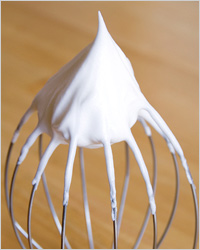
Ingredients:
1 protein
30 g sugar
15 g of powdered sugar,
1.5 tbsp cold water.
Cooking:
An important note - the proteins in this recipe must be beaten by hand with a whisk. Preheat the oven to 120°C and prepare a baking sheet with baking paper. Pour the protein into a deep bowl and start whisking it with a whisk in one direction. As soon as the protein rises, turning into a transparent foam, add to it cold water Whisking continuously for about 3 minutes. Now pour sugar in a thin stream, without ceasing to beat, and then in the same way, in a thin stream, powdered sugar. Continue beating until the mixture becomes thick and dense. If you raise the whisk, the protein mass should stick to it and not fall off. Drop off the finished protein dough on a baking sheet and place in the oven for 40 minutes. The door must be closed. When the meringues are evenly creamy, reduce the temperature to 100°C and open the door a little. If your oven has a fan, turn it on. Dry the meringue in this way for about an hour. When removing the baking sheet from the oven, do not try the meringue by touch - it will be soft, but in the air the meringue will harden in just a minute.
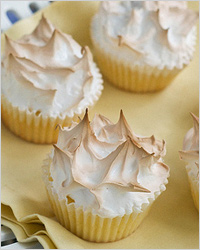
Ingredients:
1 protein
150 g powdered sugar,
chocolate chips or any syrup - to taste (for decoration).
Cooking:
Beat egg white with powdered sugar until well combined. Take paper molds for cupcakes, put in each portion of protein meringue the size of Walnut and put in the microwave. Turn on the oven at maximum power and cook for 1-2 minutes. The meringue will increase in size. After turning off the microwave, do not pull out the meringues immediately, let them cool. Garnish with chocolate or syrup.
Meringues with chocolate and berry sauce (microwave)
Ingredients:
2 squirrels,
sugar - as much by weight as proteins,
20-30 g of dark chocolate,
100 g of any berries.
Cooking:
Beat egg whites with a few drops of lemon juice until soft peaks form. Gradually add the sugar while continuing to beat and increase the speed. Beat until the protein mass is moist and shiny and falls off the whisk. Gently fold in the grated chocolate into the mixture. Expand by paper forms and put in the microwave for 30 seconds, no more. Power must be maximum. Let the meringues cool without removing them from the oven. In the meantime, prepare berry sauce: chop the berries in a blender and rub through a sieve. Put the cooled meringues on a dish and pour over the berry sauce.
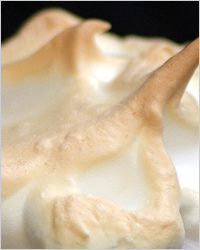
Ingredients:
8 proteins,
200 g sugar
150 g powdered sugar,
30 g starch,
150 g ground nuts (walnuts or hazelnuts).
Cooking:
Whisk the egg whites until fluffy, gradually adding sugar. powdered sugar mix with starch, sift and quickly and gently fold into beaten egg whites. Stir with a wooden spoon, put the resulting mass into a pastry syringe or an envelope with a large star nozzle and deposit the meringue on a baking sheet covered with paper. Place the baking sheet in the oven preheated to 100°C for 8 hours. Open the door a little. Remove the dried and cooled meringue from the baking sheet, store in a dry cool place. In the same way, you can cook Chocolate meringue, only in the recipe, replace the nuts with the same amount of grated chocolate.
Ingredients:
3 squirrels,
200 g powdered sugar,
250 g cream
400 g strawberries
1 tbsp vanilla sugar
½ tsp lemon juice.
Cooking:
Beat the protein, gradually adding 150 g of sugar, then add the lemon juice. Mix well, add the remaining sugar and beat well again. On the back of the paper with which you will cover the baking sheet, draw circles (circle a glass or cup). Fill a piping bag fitted with a round tip and pipe the egg white onto the mugs in a spiral motion. Then change the nozzle to a star one and plant small roses along the edge of the circles to make baskets. Put in the oven, preheated to 80-100 ° C, and dry the baskets for 2 hours. Whip cream with vanilla sugar. Wash the strawberries, dry and cut into quarters. Fill cooled baskets butter cream and garnish with strawberries.
Except air cookies and baskets exist delicious desserts based on meringue. This and wonderful airy dessert Pavlova and cake Count's ruins”, and the highest achievement of Soviet culinary thought, which appeared as a result of an oversight - the Kievsky cake. But that's a topic for another article.
Good luck and bon appetit! (Stay with us!)
Larisa Shuftaykina













